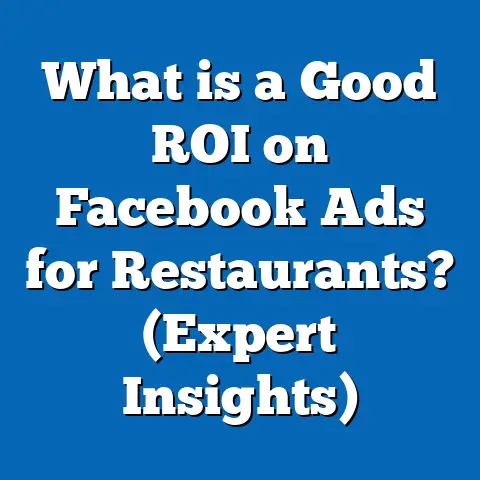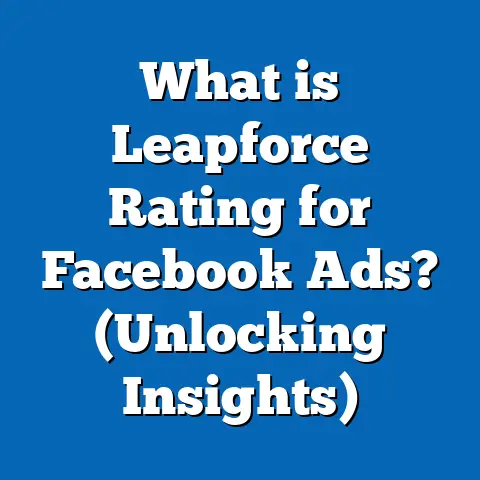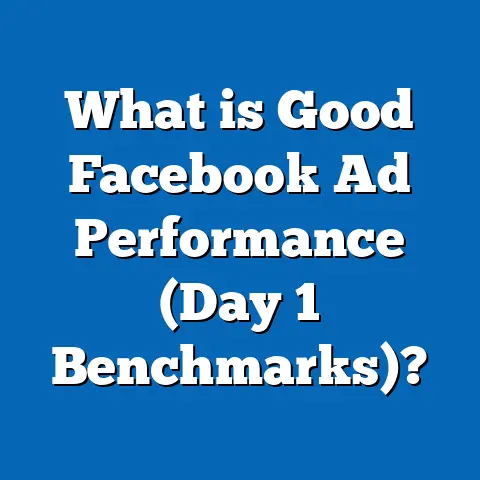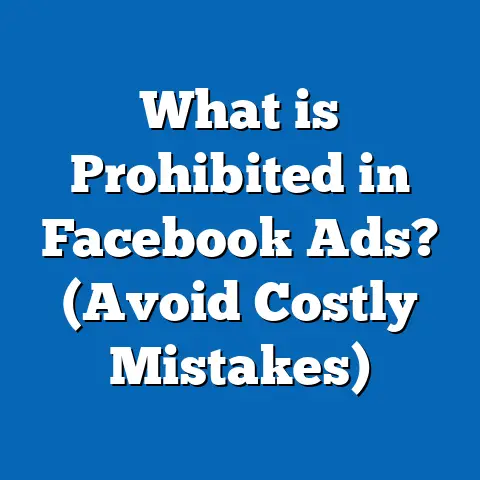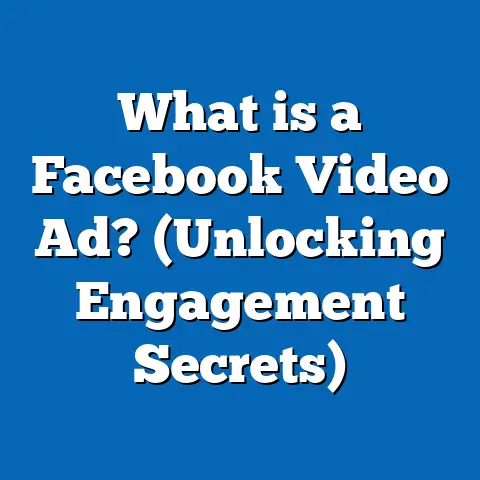What is Good Cost Per Click? (Unlocking Profitable Ads)
What is Good Cost Per Click? (Unlocking Profitable Ads)
Introduction: Why Cost Per Click Matters for Your Family and Business
Imagine a family dinner table where everyone shares stories about their day, hopes, and dreams. For many business owners, these stories include the challenges and triumphs of growing their business. You may be investing time, hard work, and your savings into your business because you want to provide a better life for your family. In this journey, every dollar you spend on marketing is precious. You want to make sure it works hard for you — reaching the right people, sparking interest, and turning clicks into loyal customers.
In today’s digital world, Facebook advertising offers immense potential to connect with your target audience. But how do you know if you’re spending your ad budget wisely? That’s where Cost Per Click (CPC) comes in. Understanding CPC helps you measure how efficiently you pay to get potential customers to engage with your ads.
This guide will walk you through everything about CPC — what is a good CPC, how to interpret it, factors that influence it, actionable strategies to improve it, and how to unlock profitable ads on Facebook. Whether you’re a marketing professional or a small business owner, mastering CPC can help you grow sustainably while supporting your family’s future.
Understanding Cost Per Click (CPC): The Basics
What is Cost Per Click?
Cost Per Click (CPC) is a pricing model in digital advertising where advertisers pay each time someone clicks on their ad. Instead of paying for just views or impressions (how many times the ad appears), you pay only when someone shows explicit interest by clicking.
For example, if your ad appears 1,000 times but only 10 people click, and you pay $10 total, your CPC is: CPC=Total CostNumber of Clicks=1010=1CPC = \frac{Total \ Cost}{Number \ of \ Clicks} = \frac{10}{10} = 1
So, you paid $1 for each click.
Why CPC Matters
- Budget Efficiency: CPC ensures you pay only when there’s engagement.
- Campaign Performance: A lower CPC often means your ad resonates well with your audience.
- Profitability Indicator: When combined with conversion data (sales or leads), CPC shows if your ad spend is profitable.
How Facebook Ads Use CPC
Facebook uses an auction system where advertisers bid for ad placements. The actual CPC depends on several dynamic factors:
- Bid Amount: How much you’re willing to pay.
- Ad Relevance Score: Facebook rewards ads that users interact with positively.
- Estimated Action Rates: Likelihood of users clicking or converting.
- Competition: Other advertisers targeting similar audiences.
What is Considered a Good Cost Per Click on Facebook?
Average CPC Benchmarks by Industry
Recent studies (2023-2024) show average CPCs vary widely by industry:
| Industry | Average CPC (USD) | Notes |
|---|---|---|
| E-commerce | $0.70 – $1.00 | High volume, competitive sector |
| Finance | $3.50 – $5.00 | High value conversions justify CPC |
| Health & Wellness | $1.00 – $2.50 | Growing demand, moderate competition |
| Technology | $1.50 – $3.00 | Niche targeting affects costs |
| Education | $1.00 – $3.00 | Often seasonal demand |
| Real Estate | $1.50 – $3.50 | Local targeting common |
| Retail | $0.80 – $1.50 | Seasonal spikes during holidays |
| B2B | $2.00 – $6.00 | Higher CPC due to niche audience |
Sources: WordStream, AdEspresso, Facebook Business Insights
What Makes a “Good” CPC?
A “good” CPC isn’t a fixed number but depends on:
- Industry Standards: Some sectors naturally have higher CPCs.
- Business Goals: Brand awareness campaigns accept higher CPCs; direct sales require lower CPC.
- Conversion Rate: High conversion rates allow higher CPCs.
- Customer Lifetime Value (CLV): The total value a customer brings over time may justify paying more per click.
Calculating Your Maximum Affordable CPC
Knowing your maximum CPC helps avoid overspending.
Example: You sell a product with a profit margin of $50 per sale. Your website conversion rate from clicks to sales is 5%. Max CPC=Profit per Sale×Conversion Rate=50×0.05=2.5\text{Max CPC} = \text{Profit per Sale} \times \text{Conversion Rate} = 50 \times 0.05 = 2.5
You can afford to spend up to $2.50 per click before breaking even.
If your actual CPC is $1.50 and conversion rate holds, you’re profitable.
Real World Example
A family-owned boutique generates $100 profit per customer lifetime and converts 4% of clicks into sales: Max CPC=100×0.04=4Max \ CPC = 100 \times 0.04 = 4
They can afford to pay up to $4 per click profitably.
How Facebook Determines Your Cost Per Click
The Auction System
Facebook’s ad auction isn’t just about who bids highest; it balances bid amount with ad quality and estimated action rate.
- Total Value = Bid + Estimated Action Rate + Ad Quality
- The advertiser with the highest total value wins the placement.
This means an engaging ad with strong relevance can win over a higher bid with poor engagement.
Ad Relevance Diagnostics
Facebook provides metrics like:
- Quality Ranking – How your ad quality compares to competitors.
- Engagement Rate Ranking – How likely users are to interact.
- Conversion Rate Ranking – How well your ad drives conversions.
Improving these scores lowers your CPC while maintaining performance.
Key Factors Impacting Your CPC
1. Audience Targeting Precision
- Narrow audiences = higher CPC but better quality clicks.
- Broad targeting = lower CPC but less qualified clicks.
Example: Targeting “new parents in New York” vs “all adults aged 25-45.”
2. Ad Relevance and Quality
Higher relevance means:
- More clicks at lower cost.
- Facebook rewards relevant ads with lower bids required.
3. Bid Strategy
- Automatic Bidding: Facebook optimizes bids for lowest cost but less control.
- Manual Bidding: You control max CPC but risk underbidding or overspending.
4. Competition & Seasonality
Holiday seasons or product launches increase competition and raise CPC.
Example: Retail ads in December often see 20%+ higher CPC.
5. Ad Placement Choices
Different placements have different average costs:
| Placement | Average CPC (USD) |
|---|---|
| Facebook Feed | $0.70 – $1.20 |
| Instagram Feed | $0.80 – $1.30 |
| Facebook Stories | $0.50 – $1.00 |
| Messenger Ads | $0.60 – $1.10 |
Choosing placements aligned with your audience behavior improves cost efficiency.
Deep Dive: Measuring Return on Investment (ROI) With CPC
Key Metrics Beyond CPC
While CPC shows cost efficiency on clicks, true profitability depends on:
- Click Through Rate (CTR): % of people who clicked after seeing your ad.
- Conversion Rate (CVR): % of clicks that result in desired actions (purchase, signup).
- Cost Per Acquisition (CPA): Cost divided by number of conversions.
- Customer Lifetime Value (CLV): Total profit expected from a customer over time.
How These Metrics Interrelate
High CTR + low CPC usually leads to better CPA.
But high CTR with low conversion wastes money — clicks don’t convert.
Example:
| Metric | Campaign A | Campaign B |
|---|---|---|
| CPC | $1 | $0.70 |
| CTR | 2% | 5% |
| Conversion Rate | 5% | 2% |
| CPA | $20 | $35 |
Campaign A has higher cost per click but lower CPA due to better conversion rate.
Strategies to Lower Your Cost Per Click While Maintaining Quality
Optimize Audience Segmentation
- Use Facebook Lookalike Audiences based on high-value customers.
- Retarget website visitors or cart abandoners.
- Exclude irrelevant groups to avoid wasting impressions.
Improve Ad Creative Quality
- Use appealing images/videos that resonate emotionally.
- Craft clear, concise copy focused on benefits.
- Test various formats (carousel, video) to see what performs best.
Increase Relevance Score
Higher relevance score reduces CPC by signaling Facebook that users find your ads valuable.
Ways to improve:
- Align ad message tightly with audience interests.
- Avoid clickbait which increases bounce rates and lowers score.
Use A/B Testing Regularly
Test variables like headlines, images, CTAs systematically.
Example:
Test Headline A vs Headline B — if B has lower CPC and higher CTR, allocate more budget there.
Adjust Bidding Strategy
Switch between manual and automatic bidding depending on campaign goals and performance data.
Case Study #1: How a Family-Owned Bakery Cut Their Facebook CPC by 40%
Background
Smith Family Bakery struggled with high CPC ($2.80) and low online order conversion (2%).
Challenge
Limited budget meant every dollar had to be efficient to grow revenue.
Strategy
- Narrowed targeting to lookalike audience based on past customers.
- Added customer testimonial videos as new ad creative.
- Began manual bidding capped at max $1.50 per click.
- Optimized landing page for faster checkout.
Results in 3 Months
| Metric | Before | After |
|---|---|---|
| Average CPC | $2.80 | $1.68 |
| Conversion Rate (Orders/Clicks) | 2% | 4% |
| Cost per Acquisition (CPA) | $140 | $42 |
| Online Sales Revenue Increase | +10% | +35% |
The bakery increased sales significantly while lowering ad costs — allowing reinvestment in growth and family welfare.
Case Study #2: Tech Startup’s Approach to Balancing High CPC With High CLV
Background
Tech startup selling SaaS solutions had high average CPC ($4) but high customer lifetime value ($1200).
Challenge
Justifying spending on expensive clicks while maintaining profitability.
Approach
- Focused on high-intent targeting (job titles, industry).
- Created detailed educational content ads increasing trust and relevance.
- Used lead nurturing with email campaigns post-click to increase conversion rate from 3% to 10%.
Outcome After 6 Months
Despite high CPCs, the startup maintained profitability due to improved conversion funnel and high CLV.
Comparing Facebook Cost Per Click With Other Platforms
| Platform | Average CPC (USD) | Strengths | Weaknesses |
|---|---|---|---|
| Facebook Ads | $0.50 – $3.00 | Deep targeting options, visual formats | Audience saturation in some niches |
| Google Ads | $1.00 – $5.00+ | High intent search traffic | Competitive & costly for some terms |
| LinkedIn Ads | $3.00 – $6.00+ | Ideal for B2B targeting | Expensive for small businesses |
| Twitter Ads | $0.50 – $2.00 | Real-time engagement | Less precise targeting options |
For most consumer-focused businesses, Facebook offers a cost-effective balance of reach and targeting precision compared to Google or LinkedIn.
Practical Tips for Managing Your Facebook Ads Budget Efficiently
- Set Clear Objectives: Define whether your goal is awareness, lead generation, or sales.
- Track Key Metrics Beyond CPC: Monitor CTR, conversion rates, CPA regularly.
- Use Automated Rules: Pause ads when CPC exceeds your threshold or performance drops.
- Leverage Facebook Analytics Tools: Use reports in Ads Manager for insights on performance by audience segment or placement.
- Schedule Ads During Peak Engagement Times: Research shows engagement patterns vary by industry and audience demographics.
- Test Different Placements: Experiment with Instagram Stories vs Facebook Feed for cost efficiency.
- Retarget Past Visitors: Retargeting campaigns often have lower CPCs and higher conversions.
- Invest in First-party Data Collection: Build email lists or CRM integration for better retargeting opportunities post-click.
The Future of Cost Per Click in Facebook Advertising: Trends to Watch in 2024 and Beyond
AI-Powered Optimization
Facebook increasingly uses machine learning algorithms that optimize bidding, placement, and creatives dynamically—often lowering average CPC while improving results.
Privacy and Data Changes Impacting Targeting Efficiency
Apple’s iOS privacy updates limit Facebook’s tracking capabilities affecting retargeting precision — potentially increasing costs unless advertisers adapt with first-party data strategies.
Video Ads Are Taking Over
Video ads generally generate higher engagement rates which can reduce effective cost per meaningful interaction compared to static images.
Increased Competition in E-Commerce & Niche Markets
Post-pandemic growth means more advertisers are competing in popular spaces — raising average CPCs especially during peak seasons like holidays or sales events.
Summary and Next Steps for Unlocking Profitable Ads via Good CPC Management
Understanding what constitutes a good Cost Per Click is essential for running profitable Facebook ad campaigns that grow your business steadily while supporting your family’s livelihood.
Key Takeaways:
- Good CPC varies by industry but should always be evaluated against conversion rates and profit margins.
- Focus on improving ad relevance, audience targeting precision, and creative quality to lower costs sustainably.
- Use data-driven methods such as A/B testing and manual bidding controls.
- Monitor performance closely with key metrics like CTR, CPA alongside CPC.
- Stay informed about platform updates and trends such as AI optimization and privacy changes to maintain competitiveness.
Actionable Next Steps:
- Calculate your maximum affordable CPC based on profit margins and conversion rates.
- Audit existing campaigns focusing on relevance scores and audience targeting effectiveness.
- Plan regular A/B tests on creative elements and audience segments.
- Implement automated rules in Ads Manager to control budget waste proactively.
- Invest time in learning new Facebook features like AI bidding tools or enhanced analytics dashboards regularly.
Mastering your Cost Per Click will unlock the full potential of Facebook advertising — driving profitable growth that benefits both your business and family over the long term.

